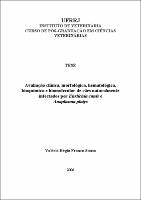Use este identificador para citar ou linkar para este item:
https://rima.ufrrj.br/jspui/handle/20.500.14407/9664| Tipo do documento: | Tese |
| Título: | Avaliação clínica, morfológica, hematológica, bioquímica e biomolecular de cães naturalmente infectados por Ehrlichia canis e Anaplasma platys |
| Título(s) alternativo(s): | Clinical, morphologic, hematological, biochemist and biomolecular evaluation of naturally infects dogs for Ehrlichia canis and Anaplasma platys |
| Autor(es): | Sousa, Valéria Régia Franco |
| Orientador(a): | Bomfim, Teresa Cristina Bergamo do |
| Palavras-chave: | cães;Ehrlichia canis;Anaplasma platys;dogs |
| Área(s) do CNPq: | Medicina Veterinária |
| Idioma: | por |
| Data do documento: | 20-Fev-2006 |
| Editor: | Universidade Federal Rural do Rio de Janeiro |
| Sigla da instituição: | UFRRJ |
| Departamento: | Instituto de Veterinária |
| Programa: | Programa de Pós-Graduação em Ciências Veterinárias |
| Citação: | SOUSA, Valéria Régia Franco. Avaliação clínica, morfológica, hematológica, bioquímica e biomolecular de cães naturalmente infectados por Ehrlichia canis e Anaplasma platys. 2006. 58 f. Tese (Doutorado em Ciências Veterinárias) - Instituto de Veterinária, Universidade Federal Rural do Rio de Janeiro, Seropédica - RJ, 2006. |
| Resumo: | Este trabalho teve por objetivo investigar a infecção por Ehrlichia canis e Anaplasma platys nos cães atendidos no Hospital Veterinário da Universidade Federal de Mato Grosso, através das técnicas de esfregaço sangüíneo e de PCR, analisando os achados clínicos e laboratoriais. Durante o período de maio de 2004 a julho de 2005 foram examinados 195 cães com sinais clínicos sugestivos de erlichiose ou com contactantes com a infecção. A trombocitopenia canina cíclica, causada pelo A. platys, provoca diminuição das plaquetas a cada 14 dias, sem provocar sinais severos, mas quando associada à infecção por E. canis a gravidade clínica aumenta. Nos treze cães atendidos com PCR positiva para E. canis foi possível verificar a diversidade de sinais, com predominância estatisticamente significativa dos distúrbios hemorrágicos. Já nos 195 cães testados pela técnica de esfregaço sangüíneo não houve predomínio de nenhum sinal clínico. Os achados hematológicos também foram inespecíficos, ocorrendo tanto anemia, leucopenia e trombocitopenia, quanto normalidade ou aumento das células. As alterações observadas na análise bioquímica não foram exclusivas dos grupos com infecção. Nestes grupos ocorreu aumento das proteínas plasmáticas, com hiperglobulinemia, sem, no entanto haver diferença significativa, apesar deste achado ser freqüente na erliquiose. A partir da análise da PCR confirmou-se que a infecção por E. canis e A. platys ocorre nos cães atendidos no Hospital Veterinário da UFMT, devendo ser tomadas medidas preventivas, principalmente no controle do vetor, já que todos os carrapatos encontrados nos cães examinados foram da espécie Rhipicephalus sanguineus. |
| Abstract: | This work had for objective to investigate the infection for Ehrlichia canis and Anaplasma platys in the dogs taken care of in the Veterinarian Hospital of the Universidade Federal de Mato Grosso, through the examination of blood smears and of the PCR, analyzing the clinical and laboratories findings. During the period of May of 2004 the July of 2005, 195 dogs with suggestive clinical signs of ehrlichiosis or had contact with the infection had been examined. The canine cyclic thrombocytopenia, caused for the A. platys, provokes reduction of platelets to each 14 days, without provoking severe signs, but when associated to the infection for E. canis the clinical gravity it increases. In the thirteen dogs taken care of with positive PCR for E. canis diagnosised by the PCR it was possible to verify the diversity of signals, with statistical significant predominance of the hemorrhagic riots. Already in the 195 dogs tested for the examination of blood smears it did not have predominance of no clinical signs. The hematologic findings had also been nonspecific, occurring in such a way anemia, leukopenia and thrombocytopenia, how much normality or increase of the cells. The alterations observed in the analysis biochemist had not been exclusive of the groups with infection. In these groups increase of plasma proteins occurred, with hyperglobulinaemia, without, however to have significant difference, despite this finding being frequent in ehrlichiosis. From the analysis of the PCR it was confirmed that the infection for E. canis and A. platys occur in the dogs taken care of in the Veterinarian Hospital of the UFMT, having to be taken writ of prevention, mainly in the control of the vector, since all the ticks found in the examined dogs had been of species Rhipicephalus sanguineus. |
| URI: | https://rima.ufrrj.br/jspui/handle/20.500.14407/9664 |
| Aparece nas coleções: | Doutorado em Ciências Veterinárias |
Se for cadastrado no RIMA, poderá receber informações por email.
Se ainda não tem uma conta, cadastre-se aqui!
Arquivos associados a este item:
| Arquivo | Descrição | Tamanho | Formato | |
|---|---|---|---|---|
| 2006 - Valéria Régia Franco Sousa.pdf | 1.51 MB | Adobe PDF |  Abrir |
Os itens no repositório estão protegidos por copyright, com todos os direitos reservados, salvo quando é indicado o contrário.

